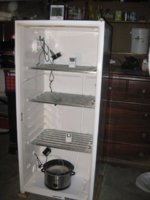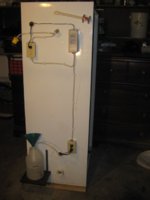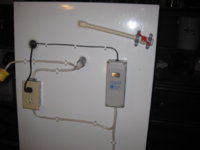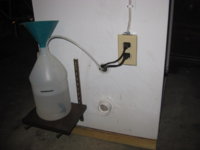This is my new fermenting kiln to date – still have to finish the door paint and seal, and a couple other things. After screwing around with an el cheapo styrofoam box & crockpot for 3 years, I can’t wait to get this running. The box is a 15 cu ft upright freezer. Photos of the inside/outside:


Starting at the top, inside (next photos)……
There are 2 small computer fans mounted on the back wall, blowing down, low volume – 25 cfm, just enough to keep the air moving. At the very top-left is a ½-inch PVC pipe air outlet (more on this later). The Ranco temperature probe/wire is hanging on the hook. The round metal box contains a water heater high temp thermostat, set at about 130°F – after sealing it in the box, I tested it by connecting a lamp and power, then placed a hot clothes iron against the faceplate – it shut of the lamp after a few seconds. I’ll need to test again after the kiln is finished to determine the exact temp that it will shut off.


At the bottom/inside,
there is the crockpot for my heat and humidity source, and a 3rd small fan blowing across the crockpot. Bottom-left is the fresh air inlet (later).

Top outside:
At the top is the ½-inch PVC air outlet with a ball valve control. From previous experience with my old kiln, it’s surprising how much air/humidity can be exhausted with such a small vent. This is how I’ll control the RH – this vent, maybe an offset lid on the crockpot, and restriction of the air inlet at the bottom. This outlet pipe is sloped to drain any condensation.

More on the top outside:
Far left, the power cord plug (1st mistake - should have extended it to near the floor). The power goes first to the high-temp thermostat – if I have an upset condition, or the Ranco probe gets buried, the power gets shut off to all, so I don’t toast my tobacco.
The power then goes to the fan outlet, they’ll run 24/7. Then to the Ranco ETC-111000 Temp Controller - will be set at 120-125°F range.
Bottom outside photo:
The lower outlet box is controlled by the Ranco - to cycle the crockpot and fan to maintain the proper temp. Note: the power cords pass thru a 1 ¼ inch PVC pipe sleeve, the cords first wrapped with closed-cell sponge foam rubber before stuffed into the sleeve – moisture/air-tight.
(edit) 2nd mistake, but I got lucky. I didn't check the length of the crockpot cord - it just barely reaches the outlet box. I should have mounted the pipe sleeve & outlet box lower.
At the bottom center is the fresh air inlet – 1 ½” PVC pipe/coupling, with a metal screen to keep out bugs/rodents. If I need to restrict air intake, I’ll cover with gauze-cloth.

Then there is the water supply – water jug on an adjustable shelf, with a siphon hose to the crockpot. The black mark on the jug is at the high water level of the crockpot. I can monitor the water level, and fill the crockpot without opening the kiln door.
It was my intent to keep all the electrical components outside the kiln, except the power cords to the fans/crockpot, for safety reasons. Power to this will be to a GFCI-protected outlet.
I have a set of remote thermometer/hydrometers (1st photo above), so I can monitor the temp/RH without opening the door. With the temp controls and water source outside the kiln, it is conceivable that I can operate this kiln for a full 4-6 week fermentation period without having to open the door even once. But I know I’ll have to inspect the tobacco occasionally, just for my own satisfaction.
The shelves in this kiln are fixed-location, but removable. This will work well for me. After curing, drying and de-ribbing my leaf, I usually pack them into a box to form small bales about 12” x 18” x whatever height – will fit ideal on these shelves. Or I can just pile the leaf on the shelf.
I’m going to install hooks on the top inside, to hang tobacco strings or hands if needed.
Also, I’m going to install clips or hooks at the top-inside of the door – to hang a ringing-wet terrycloth towel – great for bumping the RH to 90-100% to bring leaf into case.
I am open to any comments, critics, or suggestions. I’m not done yet and can still make modifications.








